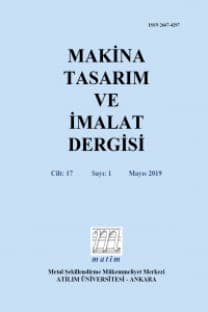Eklemeli İmalat ile Üretilen PLA Malzemelerinin Yapıştırılması: Yapıştırma Eğim Açısının ve Baskı Yolu Yöneliminin Etkileri
Bu çalışmanın amacı, eklemeli imalat ile PLA malzemeden üretilen parçaların yapıştırıcı ile bağlanmasında, bağlantısı açısının ve baskı yolu yöneliminin etkisini araştırmaktır. İlk adımda, bütün PLA numuneleri, 0º, 45º ve 90º'lik üç farklı baskı yolu yöneliminde malzeme ekstrüzyonu eklemeli imalat yöntemi ile üretilmiştir. Bu numunelerin çekme ve basma testleri, 90º baskı yolu yöneliminin en zayıf sonuçları verdiğini göstermiştir. İkinci adımda, bütün haldeki numuneyi oluşturacak iki bağlantı parçası, 0º ve 45º baskı yolu yönelimi ile üretilmiştir. Bağlantı parçalarının yapışma bölgesindeki eğim açısı 15º, 30º, 45º, 60º ve 90º olmak üzere beş farklı açı ile üretilmiş. Bütün haldeki bir numuneyi oluşturmak için aynı eğim açısı ile üretilmiş iki bağlantı parçası, eğim açısı bölgelerinden bir yapıştırıcı ile birbirlerine bağlanmıştır. Farklı eğim açıları ve baskı yolu yönelimlerinde oluşturulan bütün haldeki numunelerin çekme ve basma testleri, kırılma dayanımlarını belirlemek için yapılmıştır. Kırılma dayanım kuvvetinin, bağlantı parçasının baskı yolu yöneliminin ve bağlantı açısının bir fonksiyonu olarak ölçülebilir şekilde değiştiği; ancak çekme ve basma yükleri için farklı olduğu bulunmuştur. Bu sonuçlara bağlı olarak, PLA ile üretilmiş bağlantılı numunelerin hem basma hem de çekme yükü altında benzer kırılma dayanımına olacağı eğim açısı belirlenmiştir.
Anahtar Kelimeler:
Eğimli yapıştırma bağlantısı, eğim açısı, baskı yolu yönelimi, eklemeli imalat, PLA, Adhesive scarf joint; scarf angle; raster orientation; additive manufacturing, PLA.
Bonding Additively Manufactured PLA Materials: Effects of Joint Scarf Angle and Substrate Raster Orientation
The aim of this study is to investigate the effect of the scarf angle of the bonding region and the raster orientation of 3D printed substrates for the adhesive scarf joints made of additively manufactured Polylactic acid (PLA) adherends. In the first step, single PLA specimens were 3D printed using the fused filament fabrication (FFF) process in three different raster orientations of 0º, 45º, and 90º. Tensile and compression tests of them showed that the raster orientation of 90º gives the weakest results. Hence, in the second step, for the scarf joints, the PLA adherends were 3D printed in two different raster orientations of 0º and 45º. The joints were built with five different scarf angles of 15º, 30º, 45º, 60º, and 90º. The tensile and compression tests of all the specimens were conducted to determine the failure loads for different scarf angles and raster orientations. It is found that the endured load before rupture varies measurably as a function of the raster orientation of printed substrates and scarf angle of the joint, but differently for tensile and compression loadings. Eventually, the scarf angle for PLA scarf joints is determined which gives similar failure loads under both tension and compression loadings.
___
- 1. Attaran, M., The rise of 3-D printing: The advantages of additive manufacturing over traditional manufacturing. Business Horizons, 2017. 60(5): p. 677-688.
- 2. Gorguluarslan, R.M., et al., Design and fabrication of periodic lattice-based cellular structures. Computer-Aided Design and Applications, 2016. 13(1): p. 50-62.
- 3. Gorguluarslan Recep, M., et al., An improved lattice structure design optimization framework considering additive manufacturing constraints. Rapid Prototyping Journal, 2017. 23(2): p. 305-319.
- 4. Ozlati, A., et al., An Alternative Additive Manufacturing-Based Joining Method to Make Metal/Polymer Hybrid Structures. Journal of Manufacturing Processes, 2019. 45: p. 217-226.
- 5. Frascio, M. Joint-Design Strategies for Additive Manufacturing. 2020.
- 6. Paygozar, B., S.A. Dizaji, and L.F.M. da Silva, Bonding dissimilar materials via adhesively bonded spot-welded joints: cohesive zone model technique. Journal of Adhesion Science and Technology, 2020: p. 1-12.
- 7. Kariz, M., M.K. Kuzman, and M. Sernek, Adhesive bonding of 3D-printed ABS parts and wood. Journal of Adhesion Science and Technology, 2017. 31(15): p. 1683-1690.
- 8. Alves, D.L., et al., Effect of material hybridization on the strength of scarf adhesive joints. Procedia Manufacturing, 2019. 38: p. 1244-1251.
- 9. Spaggiari, A. and F. Denti, Mechanical strength of adhesively bonded joints using polymeric additive manufacturing. Proceedings of the Institution of Mechanical Engineers, Part C: Journal of Mechanical Engineering Science, 2019: p. 0954406219850221.
- 10. Kioshi Kawasaki Cavalcanti, D., M. Banea, and H. Queiroz, Mechanical Characterization of Bonded Joints Made of Additive Manufactured Adherends. Annals of Dunarea de Jos University of Galati Fascicle XII Welding Equipment and Technology, 2019. 30: p. 27-33.
- 11. Roy Choudhury, M. and K. Debnath, Experimental analysis of tensile and compressive failure load in single-lap adhesive joint of green composites. International Journal of Adhesion and Adhesives, 2020. 99: p. 102557.
- 12. Notta-Cuvier, D., et al., Tailoring polylactide (PLA) properties for automotive applications: Effect of addition of designed additives on main mechanical properties. Polymer Testing, 2014. 36: p. 1-9.
- 13. Kreibich, U.T. and A.F. Marcantonio, New Developments in Structural Adhesives for the Automotive Industry. The Journal of Adhesion, 1987. 22(2): p. 153-165.
- 14. Frascio, M. and E.A.S. Marques, Review of Tailoring Methods for Joints with Additively Manufactured Adherends and Adhesives. 2020. 13(18).
- 15. Paygozar, B., et al., Adhesively bonded aluminium double-strap joints: effects of patch part on failure load. Journal of the Brazilian Society of Mechanical Sciences and Engineering, 2020. 42(11): p. 589.
- 16. Ghandriz, R., K. Hart, and J. Li, Extended finite element method (XFEM) modeling of fracture in additively manufactured polymers. Additive Manufacturing, 2020. 31: p. 100945.
- ISSN: 1302-9487
- Başlangıç: 1986
- Yayıncı: Makina Tasarım ve İmalat Derneği
Sayıdaki Diğer Makaleler
Bahman PAYGOZAR, Recep Muhammet GÖRGÜLÜARSLAN
Çözücü Değiştirme Yöntemi ile Poli (eter eter keton) (PEEK) Kompozitlerinin Üretilmesi
Dikdörtgen Kesitli Disk Yayların Yapay Sinir Ağı İle Optimizasyonu
Yoğun Bakım, Yanık Tedavi ve Fizik Tedavi Kombine Hasta Karyolasının Kavramsal Tasarımı
Harun SÜMBÜL, Ahmet BÖĞREK, Abdurrahman TUNÇER
Görüntü Korelasyon Tekniği Kullanılarak ABS 3B Baskıların Kayma Modülü Analizi
